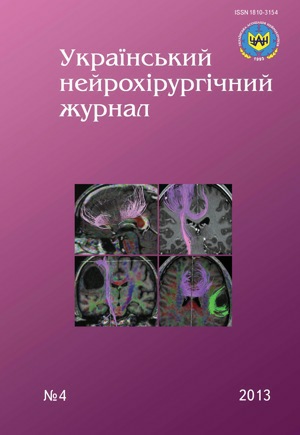New experimental neurosurgical technologies of delayed cranioplasty after large bone-flap craniotomy
DOI:
https://doi.org/10.25305/unj.55405Keywords:
large bone-flap craniotomy, extracorporeal and intracorporeal maintaining of the bone flap, delayed cranioplastyAbstract
Purpose: to develop measures of craniotomy for convenience and efficiency of delayed cranioplasty improving.
Methods. A new method of delayed cranioplasty after large bone-flap craniotomy in rats was described using extra- and intracorporeal maintaining of the bone graft after removing a large portion (50%) of the scull cap and placing shims between dura mater and lamina vitrea and between dura mater and galea aponeurotica m. occipitofrontalis in the projection of the wound.
Results. Complete restoration of the anatomic integrity of the bones of the skull cap was observed, there was no rough adhesions of soft tissue.
Conclusions. The proposed technique allows to perform safe, efficient and convenient for the surgeon large bone-flap craniotomy followed low-impact delayed cranioplasty.References
1. [New approaches and technologies in the treatment of traumatic brain injury]. In: Abstract Book of the Conference of Neurosurgeons of Ukraine “Dosyahnennya neyrokhirurhiyi ostann’oho desyatyrichchya” v ramkakh mizhnar. med. forumu “Innovatsiyi v medytsyni — zdorov’ya natsiyi” ["Achieving neurosurgery last decade" within the Intern. Med. Forum "Innovations in Medicine - Health of the Nation"]; 2012 September 26-27; Kiev, Ukraine. Kiev, 2012. p.23-35. Russian.
2. Pedachenko EG, Dzyak AH, Sirko AG. [Effective reduction of intracranial pressure in patients with severe traumatic brain injury using unilateral decompressive craniektomiy]. Ukr Med Chasopys. 2011;4(84):120-3. Ukrainian.
3. Dzyak LA, Sirko AG, Suk VM, Skripnik AF. [Effect of the initial level of intracranial pressure in the coming prognosis of severe head injury]. Ukr Visn Psikhonevrologii. 2011;19(3):12-6. Russian.
4. Zozulya YuP. [Modern lines of development of new technologies in neurosurgery]. Bulletin of the Ukrainian Association of Neurosurgeons. 1997;(3):4. Ukrainian.
5. Danchyn OH, Tul’chyns’kyy GV, Burkovs’kyy MV. [Modern aspects of cranioplasty - literature review]. Ukr. Zhurn Maloinvazyv ta Endosk. Khirurhiyi. 2012;5(4):50-8. Ukrainian.
6. Kos VT, Bek FV, Spetsler RF, editors. [Clinical microneurosurgery]. Moscow: Meditsina; 1980. Russian.
7. Marion DW. Decompressive craniectomy in diffuse traumatic brain injury. Lancet Neurol. 2011 Jun;10(6):497-8. [CrossRef] [PubMed]
8. Romodanov AP, Zozulya YuA, Mosiychuk NM, Chushkan GS. [Atlas of brain surgery]. Moscow: Meditsina; 1980. Russian.
9. Gaydar BV. [Practical neurosurgery]. StPeterburg; 2002. Russian.
10. Hryhor'yev YeO, Nakhaba OO, inventors. Bone plastic method of surgical treatment of intracranial hematomas in children under 18. Ukraine Patent 23742A. 2007 June 11.
11. Tsymbalyuk VI, Zozulya YuP, Nakhaba OO, Hrydina NYa, inventors; Romodanov Neurosurgery Institute, Kiev, Ukraine, assignee. Method of large flap craniotomy in mammalian with flap extracorpopral saving after removal of large fragments of calvaria. Ukraine Patent 20724A. 2010 June 25.
12. Tsymbalyuk VI, Nakhaba OO, Gridina NYa. [Analysis of the effectiveness and convenience of deferred cranioplasty velykoloskutnoyi after craniotomy in vitro preservation of mammalian bone flap after the removal of large fragments of skull vault]. Nauk Visn. NMU im. O.O. Bohomol’tsya. 2011;1:45-8. Ukrainian.
13. Tsymbalyuk VI, Nakhaba OO, Gridina NYa. [Deferred large flep cranioplasty after craniotomy (modification #3 and #4)]. Nauk Visn. NMU im. O.O. Bohomol’tsya. 2011;3:39-43. Ukrainian.
14. Tsymbalyuk VI, Nakhaba OO, Gridina NYa. [Deferred large flep cranioplasty after craniotomy (modification #5 and #6)]. Nauk Visn. NMU im. O.O. Bohomol’tsya. 2011;2:28-31. Ukrainian.
Downloads
Published
How to Cite
Issue
Section
License
Copyright (c) 2013 Alexander Nakhaba, Nina Gridina, Anna Shmeleva

This work is licensed under a Creative Commons Attribution 4.0 International License.
Ukrainian Neurosurgical Journal abides by the CREATIVE COMMONS copyright rights and permissions for open access journals.
Authors, who are published in this Journal, agree to the following conditions:
1. The authors reserve the right to authorship of the work and pass the first publication right of this work to the Journal under the terms of Creative Commons Attribution License, which allows others to freely distribute the published research with the obligatory reference to the authors of the original work and the first publication of the work in this Journal.
2. The authors have the right to conclude separate supplement agreements that relate to non-exclusive work distribution in the form of which it has been published by the Journal (for example, to upload the work to the online storage of the Journal or publish it as part of a monograph), provided that the reference to the first publication of the work in this Journal is included.









